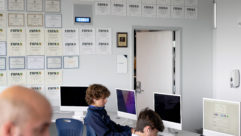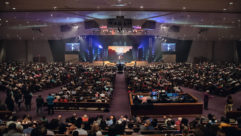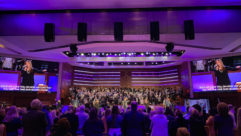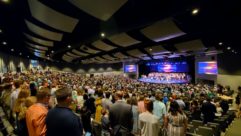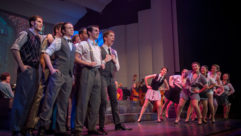
Auditorium Adds Mission Critical AV
Consulting firm Booz Allen Hamilton upgrades the AV in its corporate auditorium while keeping it functional for high-profile government clients.
CLIENTS TYPICALLY have high expectations when it comes to the AV services provided by local vendors. For Booz Allen Hamilton, a global strategy and technology consulting firm based in McLean, VA, those expectations are magnified thanks to a list of high-profile clients that include the Department of Defense, as well as other government agencies and corporate clients based in and around the Washington, D.C., area.Under pressureControl roomNOISY COMPUTERS IN TIGHT QUARTERS
CHALLENGE: Upgrade a popular corporate auditorium, including replacing 147 daisy-chained microphones and installing new audio and video systems, while keeping the space operational for clients.
SOLUTION: Take advantage of a two-week holiday break to remove most of the components and complete 147 home runs to each seat for new microphones.
Booz Allen’s popular corporate meeting space at its headquarters known as the Newman Auditorium, named after the late Booz Allen Senior Vice President John Newman, is often used by its clients for meetings, classified events, and other briefings. It’s common for the auditorium to be reserved at least a year in advance with its technology features in constant demand. “A point came when we recognized the need to overhaul our systems to meet the increasingly complex AV needs of our users,” says Gary L. Hall, CTS-I, CTS-D, regional AV lead for the firm. “Auditorium redesign planning started in 2002. So in 2004, we began execution of a project to overhaul the systems in the Newman Auditorium.”
Hall, along with colleague Edwin Morman, CTS-I, worked with teams from different areas within the company to best determine the needs for the 147-seat space. “Newman Auditorium was built 10 or 11 years ago, and needed an overall upgrade to take advantage of advances in technology,” Hall says. “We were experiencing systems issues during meetings. It was just aging equipment that was under a lot of daily use and stress.”
The auditorium also suffered from an ailing sound system, one with patchwork processing and problems interfacing with the firm’s protected wire distribution system for classified signals. However, once the AV upgrades were identified, the install plans were ultimately approved by the firm’s systems resource center director, the conference center manager, and the facilities director. In total, the cost for the project hovered around $1 million.
Under the plan, certain physical aspects of the auditorium wouldn’t change, such as the 10×20 raised stage area and the 10- by 20-foot rear-projection screen; however, the entire technology backbone needed to be dismantled and upgraded. “We received a call from Gary in late November that Booz Allen requirements were to have the auditorium partially operational by the first week in January and fully operational by the first week in March,” says Rick Winde, national accounts director, Systems Division, for Professional Products Inc. (PPI) in Gaithersburg, MD. PPI had a relationship with Booz Allen and was working on a conference center for the firm at the time.
The only hitch in the plan was that the Phase 1 portion of the project wasn’t approved until about 30 days prior to the integration, well below the anticipated — and often required — 90 days. To compound the timeline issue, the Newman Auditorium was only available for this phase over a two-week stretch during the holidays from December 17 to January 3. “We put very challenging requirements on PPI, no question,” Hall says. “The job was specified at 30 days out because we were still tweaking what we wanted internally. We had to accommodate everyone’s needs, which wasn’t an easy task.”
January 4th represented a hard stop deadline because a high-level classified war gaming exercise by the Joint Chiefs of Staff would occur in the auditorium that day. After January 4th, there was still installation work to be done, but the room had to be functional. After that date, PPI worked around the auditorium schedule, mostly on nights and weekends to finish the first phase, which was completed in March 2005. The major work for Phase 2 started in August and was completed in September 2005.
Due to the short installation time for Phase 1, PPI had to do much of the engineering on the fly, which meant redesigning some elements of the install as it occurred. PPI System Design Engineer Kevin Filano and Project Manager Stephen Losquadro worked closely with Hall and Morman to ensure a smooth operation. First, it was out with the old: The former control room was completely dismantled and its components were removed; 147 seats were taken apart and removed; all phone lines to the seats were removed for security reasons and because they were no longer needed for a modem connection; and all 147 old delegate microphones daisy-chained at each seat were removed.
“We performed the integration in steps, and focused on project management,” Winde says. “The first major hurdle was cabling; once the old microphones were out, we had to do home runs from each microphone, which basically took a whole weekend.”
Not only did that mean outfitting 147 microphones with push-to-talk capabilities, but also conducting cable pulls and installing the new AKG GN15E 6-inch gooseneck microphones with an AKG CK-80 module and an AKG H600 shock mount. The connectivity the old phone lines provided was replaced with 76 Altinex Tilt and Plug Jr. tabletop interconnect boxes that brings power and Ethernet to each seat. Morman coordinated the Booz Allen facilities staff, as well as the electrical, network, and telco contractors for all of the other work to occur in conjunction with the AV upgrade.
The new microphone system runs on one of the largest Symetrix Symnet audio networks ever built. The Symnet system works on a bus system that’s capable of sending 64 reusable audio bus signals in a loop through up to 15 boxes, and uses CobraNet to link multiple rings. PPI worked with Symetrix to come up with an I/O layout that allowed for a flexible mixing architecture for all 147 microphones, as well as advanced features such as video following audio.
Utilizing Symetrix RS232 features, PPI could take advantage of the Crestron Pan/Tilt camera system’s automatic or cued camera preset recall. When a microphone’s push-to-talk button is pressed, the camera automatically moves to that preset. “The Symetrix system was a huge change for us,” Hall says. “It allowed vast flexibility in the way we handled audio by easily creating separate mixes for zoned sound reinforcement, record decks, and other outputs such as the Tandberg 6000 videoconferencing codec and the ClearOne GT1524 teleconferencing system.”
Another huge design change occurred in the auditorium’s control room. Previously, the control room featured black and white Crestron touchpanels running on antiquated code that was no longer supported. As a result, Booz Allen staff couldn’t cost-effectively modify it.
“The lack of uncompiled code and the inability to update the compiled code loaded on the processors prevented us from updating the control system when new equipment or features were added,” Hall says. “This was one of the two primary reasons for the upgrade. We had to abandon the previous system and all of the code.” Because of this and other code issues, Booz Allen now includes terms in its RFPs that clearly states that it retains ownership of all code generated for a particular project.
The new room layout doubled the number of tech stations from two to four, and was designed around the updated Crestron system. Custom workstations by Interpretive Woodworking were designed to create more space for everyone without expanding the footprint of the room. The four stations consist of a presentation station for meeting control and web streaming operation, an audio station for audio control and recording, a video station for video switching and recording, and a camera station for camera control. Each station has a Crestron TPS 6000 panel. The camera control station has two Crestron camera control units connected to Crestron PTZ-mounted Panasonic cameras.
Inside the auditorium, other control units were installed including a Crestron STX1700 wireless panel for clients, Crestron TPS 2000 panels for basic room controls, and a Crestron UPX-2 presentation processor in the lectern. While Phase 2 of the install was underway, Booz Allen utilized the minimum requirements, such as one onstage microphone and one projector instead of two, to keep the facility active. To lend a hand and minimize downtime to the facility, Crestron factory engineers programmed on the weekends.
But, unfortunately, even the best planning can’t stop a catastrophic failure in equipment. “During this time, one of the old projectors failed,” Hall says. “A new projector wasn’t in the original scope of the project, so we pulled a projector from the conference center. But it was ceiling-mounted and wasn’t the right type for rear projection. We eventually saw to it that projectors were added to the upgrade.”
Hall and Morman worked with PPI to specify new Christie DS+60 SXGA+, 6,000-lumen DLP digital projectors. “The only problem was that they weren’t manufactured yet, so we had to wait a few months,” Hall adds. “We now have three of the first machines off the assembly line. It was a good choice to go with DLP. I like the improved contrast and sharper images.”
For More Information
- AKG www.akgusa.com
- Altinex www.altinex.com
- Christie Digital www.christiedigital.com
- ClearOne www.clearone.com
- Crestron www.crestron.com
- Extron www.extron.com
- Interpretive Woodworking www.iwd-i.com
- JBL www.jblpro.com
- Noren Products www.norenproducts.com
- Panasonic www.panasonic.com
- PESA www.pesa.com
- QSC www.qscaudio.com
- Sharp www.sharpusa.com
- Shure www.shure.com
- Sennheiser www.sennheiser.com
- Symetrix www.symetrixaudio.com
- Tandberg www.tandberg.net
- Vista Systems www.vistasystems.net
To further the video experience, the team installed a Vista Systems Spyder screen processor with a composite option that feeds signals to the left and right Christie projectors. The system edge-blends the two projectors with a 20 percent overlap to fill the 20×9 screen, and creates a single imaging palette of 2400×1050 pixels that can display up to four simultaneous sources from the Extron Crosspoint 450 Plus 3232 RGB router and two PESA Cougar 32×32 video routers. Presenters can also use scalable windows and custom backgrounds on the palette. Additionally, two Sharp 36-inch LCD displays are used as stage monitors to receive the 16:9 output of the Spyder system.
The auditorium’s audio system was also completely remodeled. “Once you start to experience audio issues, meetings can lose their effectiveness,” Hall says. “Sometimes it’s the systems that you don’t notice that make the biggest difference.”
That said, Booz Allen invested in 28 JBL Control 26CT 6-inch ceiling speakers for sound reinforcement and audioconferencing, powered by QSC CX amplifiers. Six Shure UHF series wireless microphones were reused, along with three new AKG GN-50 microphones for stage audio collection. Wired microphones are often used in classified recordings when presenters step away from the lectern because wireless can’t be used for classified meetings. Two AKG GN-50 microphones were installed on the lectern and five Sennheiser ceiling shotgun microphones were repositioned overhead for ambient recording.
Thanks to the coordinated efforts of PPI and Booz Allen, the January 4th Joint Chiefs of Staff meeting occurred without incident. Although the systems weren’t fully functional until several months later, steps were taken to allow for the full use of the Newman Auditorium while the final upgrades were completed.
Controlling the additional AV systems in the Newman Auditorium meant doubling the number of technicians needed in the control room without the ability to double the space. Such tight quarters meant that controlling ambient noise from components — especially computers — was critical. The high computer noise level in the control room was solved by putting the CPUs in a Noren Products AcoustiLock cabinet.
The AcoustiLock cabinet provides a nearly airtight seal when the front door and rear cable channels are closed, which translates to a dramatic noise reduction. To prevent overheating of the CPUs, the AcoustiLock cabinet allows air exchange via an acoustic labyrinth located on the bottom of the cabinet.
According to Noren Products, the labyrinth is designed to allow very little noise to escape. Excess heat is then pumped out through another acoustic labyrinth in the cabinet.
Linda Seid Frembes is a freelance writer and PR specialist for the professional AV industry. She can be reached at [email protected].


